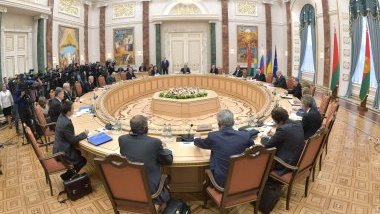Between economic freedoms and ‘sovietization’- the emergence of Eurasia
Often considered as the incarnation of Vladimir Putin’s nostalgia for the former Soviet Union, the Eurasian Union has been largely ignored by the West. In fact, it was in the margins of a Eurasian Union summit in the Belarus capital Minsk in August 2014 that Mr Putin met the Ukrainian president, Petro Poroshenko whose predecessor, Viktor Yanukovych, has advocated Ukraine’s accession to the project, thus rejecting a deal with the European Union that touched off last winter’s protests in Kiev.
In addition to Belarus and Kazakhstan, the Kremlin favors Kyrgyzstan’s accession to the Community. Recently, Armenia’s president, Serzh Sargsyan, has said he will join. However, Ukraine’s President Petro Poroshenko has just been accorded the role of an observer.
Russian officials do not hesitate to point out the Union’s potential, suggesting that trade could include all economic sectors from Belarus’s heavy machinery to Kazakhstani beef. Furthermore, they emphasize the growth of exchanges within the Eurasian Union by over 30% since 2011. Yet Mr Trenin considers that the economic benefits of expansion are questionable. For annual trade growth has been more like 1.5%, thus discounting the initial burst after the removal of trade barriers in early 2011. Nevertheless, the Union’s own trade minister, Andrey Slepnev, does not think it will pull Russia’s economy out of stagnation.
Given such pessimistic presumptions, one might wonder what the Eurasian Union is for. According to the former Armenian foreign minister, Alexander Arzoumanian, Russia envisages domination over small Member States and assure the resurrection of the former Soviet Union. However, Mr Slepnev insists that Russia exercises no control over others. It seems that Mr. Slepnev’s statement is founded as in June Belarus and Kazakhstan vetoed a Russian effort to get the Eurasian Union to block duty-free imports from Ukraine. Moreover, Russia had to resign its plan for the establishment of an Eurasian parliament after Kazakhstan’s objection According to Konstantin Sonin of Moscow’s Higher School of Economics, smaller members are expected to gather the economic benefits of integration, in particular in the form of lower energy prices from Russian producers such as Gazprom and Rosneft. Without such carrots, he says, countries like Belarus would turn to the EU, just as Ukraine since last winter.
However, in spite of the lack of economic benefits for Moscow, Vladimir Putin’s desire for establishing the Eurasian integration may appear astonishing. Some analysts argue that Russia seeks footholds in countries such as Ukraine and Armenia not to control them, but just to prevent any form of Western influence. As far as the clocks in the Eurasian Union’s Moscow lobby are concerned, some analysts suggest that “Russia wants not power so much as the appearance of power . Because it sees any gain for the West as a loss to itself, Russia will continue to promote its pet project” (’A brief primer on Vladimir Putin’s Eurasian dream’, in The Economist, 23rd August 2014).
Regardless of Putin’s ultimate objectives, a Eurasian trade bloc would wield considerable clout. The current three-country ECU represents a market of some 165 million people, and a combined GDP of around $2.3tn,with Kyrghizstan and Armenia in their capacities of prospective member states.
Eurasia- between political success and economic failure
The Eurasian Community’s pretended success has though not been sufficient to seduce others in the region. Thus, Azerbaijan and Moldova, tempted by the perspective of EU-membership, likewise the Central-Asian republics Uzbekistan, Turkmenistan and Tajikistan are taking into consideration Moscow’’s project. In addition, Georgia’s war with Russia in 2008 and the Euro-Maidan movement in Ukraine are like to dissuade these former USSR-republics to sign up to any Moscow-led union.
Some analysts are doubtful that any amount of pressure from the Kremlin will persuade some of these states to join. Others have are questioning the ratio of Russia’s economic and political partnership with an economically less attractive dictatorship like Belarus. It is uncertain whether the Russians themselves would welcome all – including, an influx of migrant workers entailed by an EU-inspired Eurasian Union.
“The Eurasian project is a mirage of a post-Soviet archipelago, in which authoritarian leaders use each other to preserve their power,” Lilia Shevtsova, author of ‘Putin’s Russia’, wrote recently. Economist Anders Aslund went further, by defining President Putin’s project as “a neo-imperialist hole” into which Russia was digging itself “ever deeper”.
Towards a post-Soviet revenge?
It remains questionable of what Russian intents on the future Eurasian Union may be. A way to provoke Western influence by providing for a multi-polar model? Establishing an economic union aiming at more deepen integration and cooperation or creating a ‘modern’, globalized version of the USSR in a time when the EU lacks economic growth and losses politic influence?


Follow the comments: |
|
